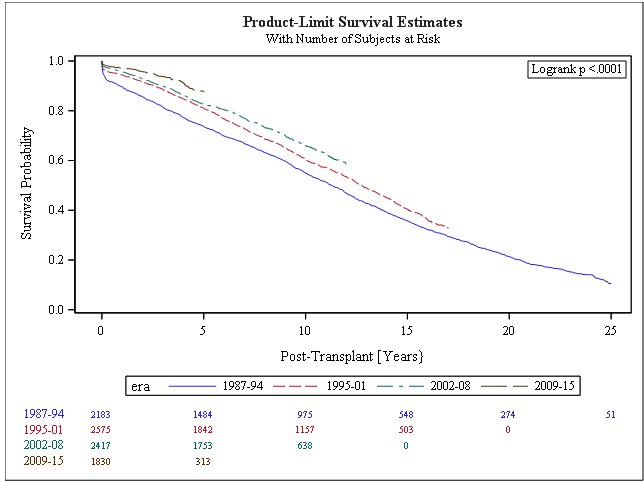Outcome of Living Donor Transplantation in Pediatric Recipients Over the Last Three Decades by Era: An Analysis of UNOS Database.
Surgery, State University New York, Syracuse, NY
Meeting: 2017 American Transplant Congress
Abstract number: 408
Keywords: Graft function, Graft survival, Kidney transplantation, Pediatric
Session Information
Session Name: Concurrent Session: Evaluation Decisions: Living Kidney Donors
Session Type: Concurrent Session
Date: Tuesday, May 2, 2017
Session Time: 2:30pm-4:00pm
 Presentation Time: 3:18pm-3:30pm
Presentation Time: 3:18pm-3:30pm
Location: E450b
Background: Living donor is the potential solution to organ shortage. This retrospective analysis of UNOS database evaluates the outcome of living donor transplantation across 4 era and report the results in the pediatric population.
Methods: Retrospective analysis of all pediatric living donor transplantation in the U.S. 1987- 2015. The era were: 1987-1994, 1995-2001, 2002-2008 and 2009-2015. The outcome pediatric transplant recipients were then analyzed. Test of equality over strata by Log Rank and Wilcoxon Statistics was used for data analysis. P value of <0.05 was considered significant.
Results: Total: 9005. Significant improvement in graft survival with each successive Cohort. 5 year outcomes: 73.69, 80.9, 82.6, and 87.7% graft survival. At 10 years: graft survival rates 55%, second era 60.4%, and the third era 66% graft survival.
See
| Era | Graft Survival ( years)
(%) |
50% GS
(years) |
95% CI | Mean/SE | |||||||
| 0 | 5 | 10 | 15 | 20 | 25 | ||||||
| 1987-1994 | 99.5 | 73.69 | 55.0 | 35.8 | 21.25 | 10.58 | 11.3 | 10.69-11.85 | |||
| 1995-2001 | 99.5 | 80.9 | 60.4 | 40.2 | . | . | 12.71 | 12.30-13.26 | |||
| 2002-2008 | 99.5 | 82.6 | 66.0 | . | . | . | . | . | 9.58/0.080 | ||
| 2009-2015 | 99.8 | 87.7 | . | . | . | . | . | . | 4.66/0.026 | ||
and  . Rank statistics and test of equality over strata showed p value <0.0001.
. Rank statistics and test of equality over strata showed p value <0.0001.
The late outcome at 25 years in the first era 10.58. Median age 12, 12, 12, 11 with each successive era, donor age 36, 37, 37, years respectively. Biological relatedness: 98.6, 95.3, 88.5 and79.7%. T50% Living vs DD 11.3 vs 6.6, 12.7 vs 9, >13 vs 9.6 years in each successive era.
Conclusion:
Significant improvement in graft survival in living donor transplants pediatric population. Based on half life, they remain a good choice for pediatric patients. Improved care and advances in immunosuppressive therapies likely resulted in the outcome. Opportunities for improved graft survival still exist for the long term.
CITATION INFORMATION: Whittaker V, Laftavi M, Acun Z, Gruessner R, Gruessner A. Outcome of Living Donor Transplantation in Pediatric Recipients Over the Last Three Decades by Era: An Analysis of UNOS Database. Am J Transplant. 2017;17 (suppl 3).
To cite this abstract in AMA style:
Whittaker V, Laftavi M, Acun Z, Gruessner R, Gruessner A. Outcome of Living Donor Transplantation in Pediatric Recipients Over the Last Three Decades by Era: An Analysis of UNOS Database. [abstract]. Am J Transplant. 2017; 17 (suppl 3). https://atcmeetingabstracts.com/abstract/outcome-of-living-donor-transplantation-in-pediatric-recipients-over-the-last-three-decades-by-era-an-analysis-of-unos-database/. Accessed December 18, 2025.« Back to 2017 American Transplant Congress
